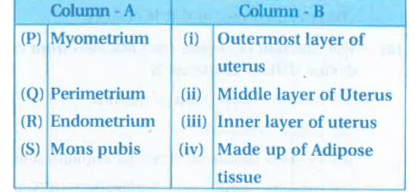Match the following
Column-IColumn-II(A)SO2(P)Secondary pollutant (B) PAN(Q) odegradable(C) Cow dung(R)Non-biodegradable (D) DDT (S) Primary pollutant Solution in Telugu
The correct Answer is:A-S;B-P;C-Q;D-R
Step by step video, text & image solution for Match the following {:("Column-I","Column-II"),((A) SO_(2),(P)"Secondary pollutant "),((B) " PAN",(Q) " odegradable"),((C)" Cow dung",(R)"Non-biodegradable "),((D)" DDT ",(S)" Primary pollutant "):} by Chemistry experts to help you in doubts & scoring excellent marks in Class 11 exams.
Topper's Solved these Questions
- BOOK - AAKASH SERIESCHAPTER - ENVIRONMENTAL CHEMISTRYEXERCISE - PRACTICE SHEET (SECTION- D : SUBJECTIVE TYPE QUESTIONS )7videos
ENVIRONMENTAL CHEMISTRY
- BOOK - AAKASH SERIESCHAPTER - ENVIRONMENTAL CHEMISTRYEXERCISE - PROBLEMS12videos
ENVIRONMENTAL CHEMISTRY
- BOOK - AAKASH SERIESCHAPTER - ENVIRONMENTAL CHEMISTRYEXERCISE - PRACTICE SHEET (SECTION -B : LINKED COMPREHENSION TYPE QUESTIONS)6videos
ENVIRONMENTAL CHEMISTRY
- BOOK - AAKASH SERIESCHAPTER - ELEMENTS OF CARBON FAMILYEXERCISE - OBJECTIVE EXERCISE - 3 (Recent AIPMT/NEET Questions)10videos
ELEMENTS OF CARBON FAMILY
- BOOK - AAKASH SERIESCHAPTER - GENERAL ORGANIC CHEMISTRYEXERCISE - QUESTIONS FOR DESCRIPTIVE ANSWERS35videos
GENERAL ORGANIC CHEMISTRY
Similar Questions
The TLV of CO is _____ppm.
04:29View SolutionDissolved oxygen values of four water samples A, B, C and D are respectively 6 ppm, 5 ppm, 1 ppm and 3 ppm. Which is more polluted?
05:27View SolutionAtmosphere, hydrosphere, lithosphere and biosphere are the four main segments of the environment. Atmosphere is a cover of gases that extends to a height of about 1600 km above the surface of the earth and protects the life on the earth from harmful radiations coming from the sun or the outer space. Atmosphere is further divided into four regions such as troposphere, stratosphere, mesosphere and thermosphere. Hydrosphere forms that part of the environment which contains water. Lithosphere is the solid component of the earth consisting of soil, rocks, mountains etc. Biosphere is that part of the above segments where living organisms interact with these parts and live together.
Which of the following is the coldest region ?03:17View SolutionThe correct order regarding the electronega tivity of hybrid obritals of carbon is
02:31View SolutionMention the hybridisation stste of each carbon in the following compounds.
CH3−CH=C=O,CH3−C≡C−CH3,CH3COCH3andCH2=CHCN05:47View SolutionMatch column I with column II and select the correct option from the given codes.
Column IColumn IINitrates(i)Primary pollutantE-Wastes(ii)Minamata diseaseMercury(iii)Secondary pollutantDDT(iv)Blue-baby syndromePAN(v)Electronic wastes02:18View SolutionMatch the pollution(s) in column I with the effect(s) in column II.
 01:43View Solution
01:43View SolutionMatch the following Columns. {:("Column I","Column II"),("A. DDT","1. CO, CO"_(2)),("B. PAN","2. smog"),("C. Acid rain","3. Biological magnification"),("D. Global warming","4. SO"_(2)):}
01:13View Solution[A] : PAN is a secondary pollutant . [R] : The secondary pollutants are produced by the combination of primary emitted pollutants in the atmosphere .
04:35View SolutionMatch Column - I with Column - II

PQRS(A)1243(B)2143(C)4132(D)432104:35View SolutionMatch the following columns
Pollutant typeExampleA) Biodegradablei. PaNB) Nondegradableii. HerbicidesC) Qualitativeiii. DDTD) Secondary pollutantiv.Domestic sewageView SolutionMatch the following {:("List-I","List-II"),((A)" Biodegradable pollutant ",(1)"MlSt"),((B)"Non- biodegradable pollutant",(2)"Agae"),("(C) Viable particulate sewage",(3)"Domestic"),("(D)Non-viable Particulate",(4)"Plastic"):}
02:36View SolutionMatch the following
Column-IColumn-II(A) Air pollution (P) Pb(B) water pollution(Q) Textile workers (C) Soil pollution (R)NO2(D) White lung disease (S) Acid rain04:56View SolutionMatch the pollution(s) in column I with the effect(s) in column II.
View SolutionMatch Column A with Column B

(A) (P-i), (Q-ii), (R-iv), (S-iii)
(B) (P-ii), (Q-i), (R-iii), (S-iv)
(C) (P-ii), (Q-iii), (R-iv), (S-i)
(D) (P-iv), (Q-iii), (R-ii), (S-i)02:32View Solution

